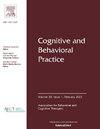Intensive Exposure Therapy for an Individual With History of Self-Harm and Suicidality
IF 2.9
3区 心理学
Q1 PSYCHOLOGY, CLINICAL
引用次数: 0
Abstract
Practitioners may hesitate to treat patients with a history of nonsuicidal self-injury (NSSI) and suicidal thoughts and behaviors (STBs) using exposure therapy due to concerns that exposures will increase these risk-related behaviors. However, when NSSI/STBs are exacerbated by distress associated with anxiety disorders or obsessive-compulsive disorder (OCD), lack of treatment can worsen disability. This case report describes the treatment of a 14-year-old gender-fluid individual with symptoms of multiple anxiety disorders, OCD, and borderline personality disorder (including emotion dysregulation, chronic suicidality, and NSSI). Treatment involved dialectical behavioral therapy (DBT) for “stage one” of treatment, including maintaining behavioral control over self-harm and suicidal behaviors, followed by intensive exposure and response prevention (ERP) during “stage two” of treatment. Upon discharge, the client had maintained an absence of NSSI/STBs, demonstrated reductions in anxiety and OC symptoms, observed further decreased familial accommodation, and improved daily functioning. In addition, the client’s parents exhibited an improved capacity to regulate their own emotions (before responding to the client), more validating responses, and reduction in familial accommodation. This case report supports the feasibility, efficacy, and safety of exposure therapy for individuals in “stage two” of DBT and highlights the role of exposure as an important emotion regulation strategy to reduce OCD and anxiety symptoms in patients with a history of self-harm and suicidality. Challenges, successes, and future directions are discussed.
为有自残和自杀史的人提供强化暴露疗法
对于有非自杀性自伤(NSSI)和自杀念头与行为(STBs)病史的患者,医生可能会犹豫是否使用暴露疗法进行治疗,因为他们担心暴露疗法会增加这些与风险相关的行为。然而,当 NSSI/STB 因焦虑症或强迫症(OCD)相关的痛苦而加剧时,缺乏治疗可能会加重残疾。本病例报告描述了对一名 14 岁的性别融合患者的治疗情况,该患者患有多种焦虑症、强迫症和边缘型人格障碍(包括情绪失调、慢性自杀和 NSSI)。治疗的 "第一阶段 "采用辩证行为疗法(DBT),包括保持对自残和自杀行为的行为控制;"第二阶段 "采用强化暴露和反应预防疗法(ERP)。出院时,该求助者仍未发生 NSSI/STB,焦虑和 OC 症状有所减轻,家庭迁就进一步减少,日常功能也有所改善。此外,当事人的父母也表现出调节自身情绪(在对当事人做出反应之前)的能力有所提高,做出了更多肯定性反应,并减少了家庭迁就。本病例报告支持暴露疗法对 DBT "第二阶段 "患者的可行性、有效性和安全性,并强调了暴露疗法作为一种重要的情绪调节策略在减少有自残和自杀史的患者的强迫症和焦虑症状中的作用。报告还讨论了面临的挑战、取得的成功以及未来的发展方向。
本文章由计算机程序翻译,如有差异,请以英文原文为准。
求助全文
约1分钟内获得全文
求助全文
来源期刊

Cognitive and Behavioral Practice
PSYCHOLOGY, CLINICAL-
CiteScore
4.80
自引率
3.40%
发文量
118
审稿时长
84 days
期刊介绍:
Cognitive and Behavioral Practice is a quarterly international journal that serves an enduring resource for empirically informed methods of clinical practice. Its mission is to bridge the gap between published research and the actual clinical practice of cognitive behavior therapy. Cognitive and Behavioral Practice publishes clinically rich accounts of innovative assessment and diagnostic and therapeutic procedures that are clearly grounded in empirical research. A focus on application and implementation of procedures is maintained.
 求助内容:
求助内容: 应助结果提醒方式:
应助结果提醒方式:


